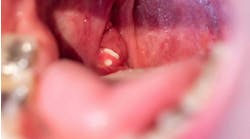Traffic congestion and tight daily schedules creates the potential for road rage. Aggressive driving habits not only strike the tardy, careless commuter, but may equally afflict the carpooling, mini-van mom, who is having “a bad day.” The American Automobile Association finds the incidents of road rage have been increasing about 7 percent every year, since first being tallied in 1990. The AAA’s advice for avoiding road rage is to not drive aggressively in a queue of traffic, but drive defensively instead. They further suggest that many traffic confrontations may best be handled by just moving out of the path of an aggressive driver, preventing unwanted hostility.
Likewise, when the oral environment is under an aggressive acid attack, cautious avoidance and steering clear of those dangerous acid confrontations will best prevent unwanted demineralization and destruction.
Hygienists see first-hand the damage that oral acids have on teeth. Patients put their mouths into unwanted acid situations and constantly put their dentition up against dangerous roadblocks. Poor self-care and dietary habits place the oral environment in compromising situations. Oral bacteria process the fermentable carbohydrates and sugars (churning them into acid).
When not adequately neutralized, these acidogenic bacterial colonies drain the vital components of calcium and phosphates from tooth structure. This weakening process is commonly known as demineralization. Keep in mind, healthy saliva acts as a buffering traffic light for the plaque acids. During the educational process, hygienists inform patients of the roles that saliva plays in calming a hostile oral environment.
Fortunately, products now entering the market are addressing the need to buffer the acids and avoid an oral collision. One such product, MI Paste by GC America, contains Recaldent, an ingredient that provides relief when the teeth are losing vital minerals. Recaldent releases phosphates and calcium ions that penetrate into the enamel, when the mouth becomes acidic. Keep in mind that both calcium and phosphates are needed for the natural remineralization or repair of the enamel.
Neutralizing a hostile environment
Many different aggressive forces provoke acid attacks on the enamel. Some of those hostile conditions afflicting patients are caries activity, enamel erosion, and xerostomia, to name just a few. When the hygienist and doctor collaborate to repair distressed surfaces, the patient benefits from both antibacterial therapies and the use of minimally invasive concepts. In treating incipient caries (non-cavitated) and white spot lesions, medicaments containing Recaldent (crèmes or chewing gums) and topically applied fluorides (in the presence of adequate salivary flow), have been shown to effectively remineralize those early lesions halt the damage and stabilize the environment.
Surface erosion brought on by chemical and mechanical issues (aggressive brush techniques, eating disorders, gastro reflux, g.e.r.d) may be protected by applying remineralizing medicaments as topical coatings. Dispensing professional products that contain Recaldent is a warranted step in enhancing self-care. Crèmes are easy to administer chairside, with a consistency that allows the material to be delivered directly by gloved fingertip. Furthermore, instructing the patient on the benefits of the ingredients found in these products is essential.
Mineral-rich saliva is important for products to perform to full acid-shielding potential. Without adequate salivary flow (such as xerostomia), the necessary calcium and phosphates are not readily available to assist in the nourishment and remineralization of the surface. Prod-
ucts which stimulate saliva production are beneficial to assist in this natural remineralizing process.
The Biotene line of products by Laclede addresses the many needs of patients suffering from a dry mouth and may be dispensed from the office or found over the counter. The mild mouthwash is antibacterial, alcohol-free, and soothing to the tissues. Having your patients regularly chew the Dry Mouth Gum stimulates saliva and acts as an acid neutralizer. The Dry Mouth Toothpaste (containing fluoride and xylitol) combats oral dryness using active salivary enzymes. Oralbalance Gel, spread onto the tongue at bedtime, will help “mouth breathers” by acting as a lubricant that keeps salivary elements available for remineralization. One may also find the gel works well for the xerostomia patient during their maintenance visits. For instance, coat the back of the mouth mirror and it will easily slide over the delicate cheek and tongue during their recare visit. Your patients will thank you for it!
To resist the acid challenge, the enamel simply must become acid resistant. It is desirable for product ingredients to bind to oral plaque pellicle and tissues. When this binding process occurs, the levels of phosphates and calcium are at a protecting level for longer durations - calming the oral environment.
Topical applications of remineralizing products may form a less penetrable surface for the acid attacks. When challenged, the acid bypasses the reinforced surfaces and instead searches for susceptible or unprotected sites to attack.
Recaldent, xylitol, and fluoride are desirable recommendations indicated for caries-prone and active caries individuals. The hygienist and doctor discuss which patients would benefit from the use of each ingredient or a combination of those ingredients and they establish an early caries protocol.
What works well for one patient won’t always work for another. It may be a matter of trial-and-error.
Perhaps an application of a Recaldent product application might be better tolerated by a younger child with rampant decay than a dose of tummy-turning fluoride gel, which could be accidentally swallowed. Also, the crown-and-bridge patient with temporomandibular dysfunction might struggle with chewing gum regularly as a lubricating measure.
Luckily, the dental community has more widely available products for repair and prevention then ever before. Put a stop to acid demineralization and aggression and give the green light to protective products.
The author did not receive compensation for product recourse in this article. For more information, visit www.recaldent.com, www.xylitolinfo.org, www.gcamerica.com, and www.laclede.com.
Karen Kaiser, RDH, graduated from St. Louis’ Forest Park dental hygiene program in 1994 and currently practices at the Center for Contemporary Dentistry in Columbia, Ill. She has written several articles for RDH and other publications, sits on dental hygiene panels, and is an evaluator for Clinical Research Associates. She can be contacted at [email protected].





